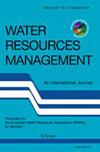Improving Linear Interpolation of Missing Hydrological Data by Applying Integrated Autoregressive Models
IF 4.7
3区 环境科学与生态学
Q1 ENGINEERING, CIVIL
引用次数: 0
Abstract
Abstract The application of linear interpolation for handling missing hydrological data is unequivocal. On one hand, such an approach offers good reconstruction in the vicinity of last observation before a no-data gap and first measurement after the gap. On the other hand, it omits irregular variability of hydrological data. Such an irregularity can be described by time series models, such as for instance the autoregressive integrated moving average (ARIMA) model. Herein, we propose a method which combines linear interpolation with autoregressive integrated model (ARI, i.e. ARIMA without a moving average part), named LinAR (available at GitHub), as a tool for inputing hydrological data. Linear interpolation is combined with the ARI model through linear scaling the ARI-based prediction issued for the no-data gap. Such an approach contributes to the current state of art in gap-filling methods since it removes artificial jumps between last stochastic prediction and first known observation after the gap, also introducing some irregular variability in the first part of the no-data gap. The LinAR method is applied and evaluated on hourly water level data collected between 2016 and 2021 (52,608 hourly steps) from 28 gauges strategically located within the Odra/Oder River basin in southwestern and western Poland. The data was sourced from Institute of Meteorology and Water Management (Poland). Evaluating the performance with over 100 million assessments in the validation experiment, the study demonstrates that the LinAR approach outperforms the purely linear method, especially for short no-data gaps (up to 12 hourly steps) and for rivers of considerable size. Based on rigorous statistical analysis of root mean square error (RMSE) – expressed (1) absolutely, (2) as percentages and (3) using RMSE error bars – the percentage improvement, understood as percentage difference between RMSE of linear and LinAR interpolations, was found to reach up to 10%.应用综合自回归模型改进水文数据缺失的线性插值
线性插值在处理水文数据缺失中的应用是不容置疑的。一方面,这种方法在无数据间隙前的最后一次观测和间隙后的第一次测量附近提供了良好的重建。另一方面,它忽略了水文资料的不规则变异性。这种不规则性可以用时间序列模型来描述,例如自回归综合移动平均(ARIMA)模型。在此,我们提出了一种将线性插值与自回归集成模型(ARI,即不含移动平均部分的ARIMA)相结合的方法,名为LinAR(可在GitHub上获得),作为输入水文数据的工具。通过线性缩放基于ARI的无数据间隙预测,将线性插值与ARI模型相结合。这种方法有助于填补空白方法的现状,因为它消除了空白后最后一次随机预测和第一次已知观测之间的人为跳跃,也在无数据空白的第一部分引入了一些不规则的可变性。LinAR方法应用于2016年至2021年间收集的每小时水位数据(52,608个每小时步骤),这些数据来自波兰西南部和西部奥德拉/奥得河流域的28个仪表。数据来自气象和水管理研究所(波兰)。在验证实验中对超过1亿次评估的性能进行了评估,该研究表明,线性ar方法优于纯线性方法,特别是对于短时间的无数据间隙(高达12小时的步骤)和相当大的河流。基于对均方根误差(RMSE)的严格统计分析——用(1)绝对、(2)百分比和(3)RMSE误差条表示——改进的百分比,被理解为线性插值和线性插值的RMSE之间的百分比差异,发现可达10%。
本文章由计算机程序翻译,如有差异,请以英文原文为准。
求助全文
约1分钟内获得全文
求助全文
来源期刊

Water Resources Management
环境科学-工程:土木
CiteScore
7.40
自引率
16.30%
发文量
332
审稿时长
9 months
期刊介绍:
Water Resources Management is an international, multidisciplinary forum for the publication of original contributions and the exchange of knowledge and experience on the management of water resources. In particular, the journal publishes contributions on water resources assessment, development, conservation and control, emphasizing policies and strategies. Contributions examine planning and design of water resource systems, and
operation, maintenance and administration of water resource systems.
Coverage extends to these closely related topics: water demand and consumption; applied surface and groundwater hydrology; water management techniques; simulation and modelling of water resource systems; forecasting and control of quantity and quality of water; economic and social aspects of water use; legislation and water resources protection.
Water Resources Management is supported scientifically by the European Water Resources Association, a scientific and technical nonprofit-making European association.
 求助内容:
求助内容: 应助结果提醒方式:
应助结果提醒方式:


